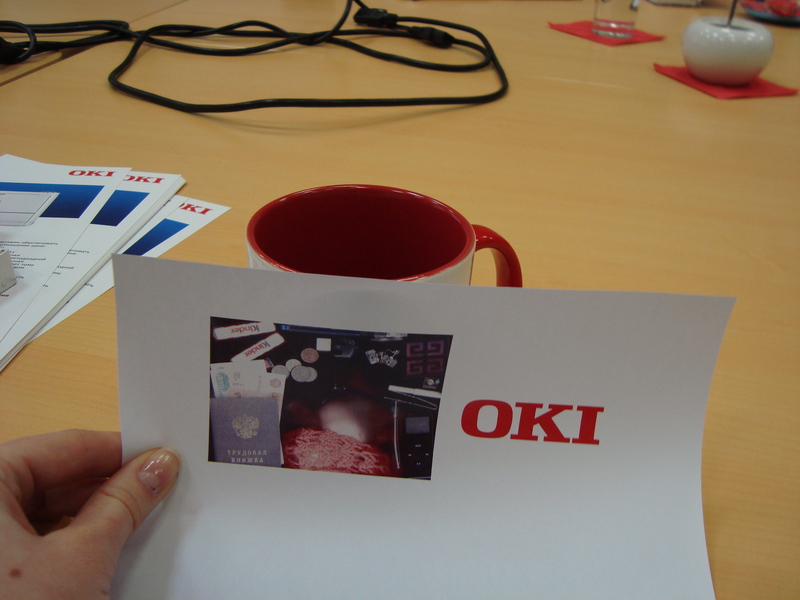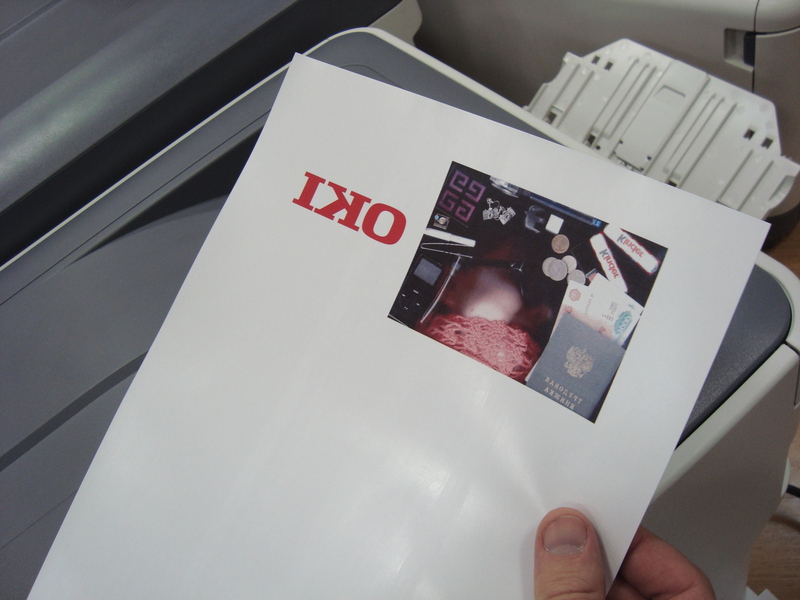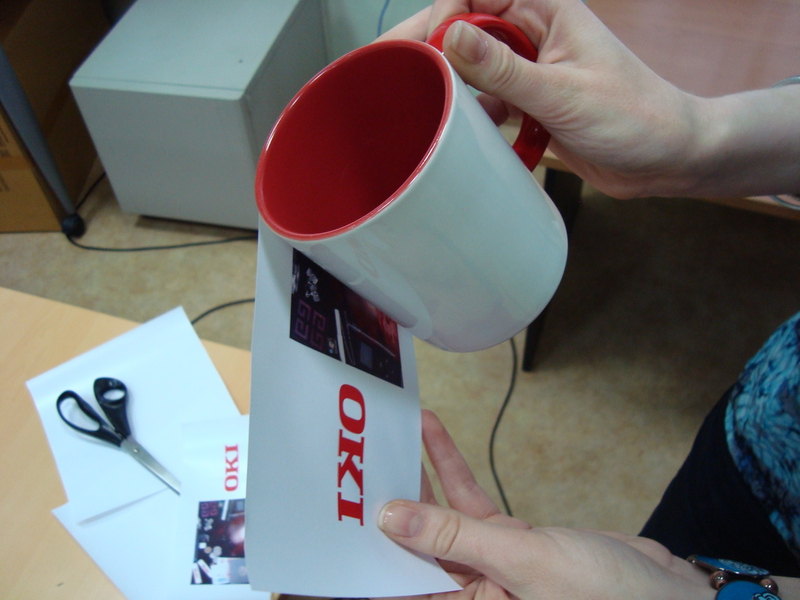Printing Circles with Thermal Transfer Paper
Surely you have already heard about the technology of applying the image on souvenirs, including mugs. In principle, there is nothing complicated here, we need the following things:
• Good photo printer
• Thermopress
• Thermal transfer paper
But not everything is so simple, thermal transfer paper is not always well processed by ordinary home printers, and even office multifunction printers are far from coping with paper. As practice has shown, when working with some printers, difficulties arise with the passage of thermal transfer paper through the fuser (the oven where toner is fixed). There are a number of factors to consider:
• Ability to print on high density paper
• Paint application temperature
• Individual printer settings
Our customers often have a question - which printer is best for printing on thermal transfer paper. We will conduct tests with various printers, but we will start with a detailed test and step-by-step story for OKI printers (Next in line is Xerox, Canon, Epson, etc.).

Printers of the C5000 and C6150 series are built using one-pass tandem technology: 4 color cartridges in them are arranged horizontally in a row, which makes it possible to ensure uninterrupted supply of media with different characteristics. Low-temperature fixing of toner allows the use of most carriers for thermal transfer, as well as a wide range of conventional materials for printing from transparencies to cardboard with a density of 200 g / m2 and more.
')
We decided to independently test various models of this manufacturer with various types of thermal transfer paper.
The first printer with which we familiarized was the compact A3 C8800n format machine. We used CMP 6.2, CPM 6.4 and CPM 6.5 Magic Touch for hard surface transfer, OBM 5.6 for transfer to colored fabric, TTC 3.1, TTC 3.3 and TTC 3.5 for transfer to white fabric.

The same paper was then used on the older model of the updated family - C5950n. In addition, TTC 3.5 was tried on the company's flagship, the C9800 printer. During printing, we found that most types of thermal transfer paper take some time to completely fix the image on them: if you try to scratch a hot print just left the printer, you can scrape the image.

However, after half a minute it becomes absolutely stable and not subject to physical impact. It is also noted that on paper OBM 5.6, intended for transfer to colored fabric, a light background appears on the white unprinted areas of paper. However, experts warned us in advance about this, having familiarized themselves with this carrier beforehand: a smooth glossy surface may cause the appearance of such printing artifacts. On the other types of thermal transfer paper, no defects were found.

When looking at the reflections of prints made on paper CPM, light bands were observed along the movement of the sheet. Most likely, they were left rubber rollers located at the exit of the sheet from the printer and in contact with the freshly fixed image. The strips were areas with slightly modified surface texture and were not colored stripes or dents on the sheet. On the final products, after thermal transfer, no traces of these bands were found.
For thermal transfer to the cups, we used a thermopress The Mug press BJ350, China. The image must be a mirror image.

Thermopress should warm up to about 120 degrees. Only after that the circle with the attached print is loaded there.


Mug with the layout is left for 15 minutes.

And here is the result

Having personally verified the validity of statements regarding the quality and ease of operation of OKI printers with different types of thermal transfer paper, we, for our part, can recommend their use for making prints and then transferring images to hard surfaces and fabrics. The following is a list of the media we used and the print options that were applied in the printer driver.
Due to the fact that thermal transfer media is not essentially paper, it is necessary to carefully select the media parameters in the printer driver, without relying on the standard thickness gauge! If the parameters are chosen incorrectly, then it is possible that the media is melted in the oven with the media winding up, then the printer will generate an error 980, which is eliminated only by replacing the oven! The parameters for the paper are shown in the table above. If you use paper of a different type or other manufacturers - be sure to carry out thorough testing before purchasing a serious amount!
• Good photo printer
• Thermopress
• Thermal transfer paper
But not everything is so simple, thermal transfer paper is not always well processed by ordinary home printers, and even office multifunction printers are far from coping with paper. As practice has shown, when working with some printers, difficulties arise with the passage of thermal transfer paper through the fuser (the oven where toner is fixed). There are a number of factors to consider:
• Ability to print on high density paper
• Paint application temperature
• Individual printer settings
Our customers often have a question - which printer is best for printing on thermal transfer paper. We will conduct tests with various printers, but we will start with a detailed test and step-by-step story for OKI printers (Next in line is Xerox, Canon, Epson, etc.).

(I apologize for the not very good picture, on the first day of testing there was only the phone at hand)
Printers of the C5000 and C6150 series are built using one-pass tandem technology: 4 color cartridges in them are arranged horizontally in a row, which makes it possible to ensure uninterrupted supply of media with different characteristics. Low-temperature fixing of toner allows the use of most carriers for thermal transfer, as well as a wide range of conventional materials for printing from transparencies to cardboard with a density of 200 g / m2 and more.
')
We decided to independently test various models of this manufacturer with various types of thermal transfer paper.
The first printer with which we familiarized was the compact A3 C8800n format machine. We used CMP 6.2, CPM 6.4 and CPM 6.5 Magic Touch for hard surface transfer, OBM 5.6 for transfer to colored fabric, TTC 3.1, TTC 3.3 and TTC 3.5 for transfer to white fabric.

The same paper was then used on the older model of the updated family - C5950n. In addition, TTC 3.5 was tried on the company's flagship, the C9800 printer. During printing, we found that most types of thermal transfer paper take some time to completely fix the image on them: if you try to scratch a hot print just left the printer, you can scrape the image.

However, after half a minute it becomes absolutely stable and not subject to physical impact. It is also noted that on paper OBM 5.6, intended for transfer to colored fabric, a light background appears on the white unprinted areas of paper. However, experts warned us in advance about this, having familiarized themselves with this carrier beforehand: a smooth glossy surface may cause the appearance of such printing artifacts. On the other types of thermal transfer paper, no defects were found.

When looking at the reflections of prints made on paper CPM, light bands were observed along the movement of the sheet. Most likely, they were left rubber rollers located at the exit of the sheet from the printer and in contact with the freshly fixed image. The strips were areas with slightly modified surface texture and were not colored stripes or dents on the sheet. On the final products, after thermal transfer, no traces of these bands were found.
For thermal transfer to the cups, we used a thermopress The Mug press BJ350, China. The image must be a mirror image.

Thermopress should warm up to about 120 degrees. Only after that the circle with the attached print is loaded there.


Mug with the layout is left for 15 minutes.

And here is the result

Having personally verified the validity of statements regarding the quality and ease of operation of OKI printers with different types of thermal transfer paper, we, for our part, can recommend their use for making prints and then transferring images to hard surfaces and fabrics. The following is a list of the media we used and the print options that were applied in the printer driver.
| Type of thermal transfer paper | Density setting in the printer driver |
| CMP 6.2, CPM 6.4 and CPM 6.5 | Medium |
| OBM 5.6 | Label 1 |
| TTC 3.1, TTC 3.3 and TTC 3.5 | Heavy |
Pay special attention:
Due to the fact that thermal transfer media is not essentially paper, it is necessary to carefully select the media parameters in the printer driver, without relying on the standard thickness gauge! If the parameters are chosen incorrectly, then it is possible that the media is melted in the oven with the media winding up, then the printer will generate an error 980, which is eliminated only by replacing the oven! The parameters for the paper are shown in the table above. If you use paper of a different type or other manufacturers - be sure to carry out thorough testing before purchasing a serious amount!
Source: https://habr.com/ru/post/156145/
All Articles